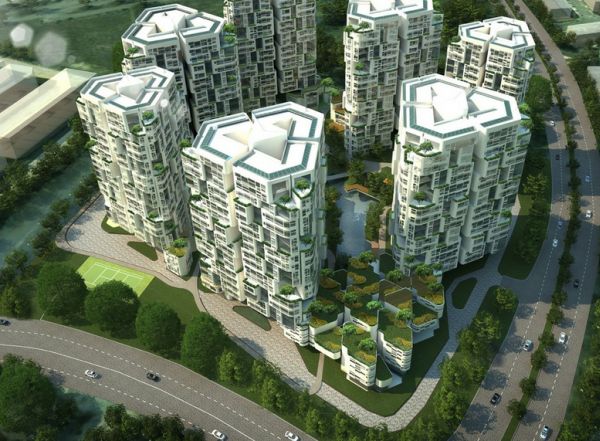Intelligent and Good-Looking!

Is it just me or does sustainable architecture look
awesome?!!! I was surveying some recent sustainable architecture project
proposals and in my humble opinion addressing sustainable aspects of our
environment seems to go hand in han with approaching the aesthetics with just
as much innovation. Technologies that are being developed to redue negative
impacts on the earth can be seen as platform for our control over how the
tectonics of the space appears.
I have always been interested in the individual as a unit of
measure for analyzing what can be done. If you have passonite, thoughtful
people designing, then the architecture, and therefore our cities will reflect
that. These things are not encouraged by some external sense of duty or the
fear of the perlis and ills that come
from the consequences of bad behavior, but instead a love and concern for self
and others. So someone asks “What does
all this have to do with good-looking architectures sustaible architecture?
It is my understanding that in whatever we set out to do we
must take care of the whole person: physically, spiritually, mentally and
emotionally. Environmental
sustainability addresses our physical selves only. It is beyond this that
architecture can be used to improve the other aspects of the individual.
Being aesthetically innovative and thoughtful in architecture
inspires (spirit) others to be creative and thoughtful in their own
contributions to the world. The value embodied in the architecture instills a
sense of value in the partakers subliminally. Knowing that someone has taken
such care to give you something so beautiful and meaningful emotionally
registers no matter what it is. I think that is why God tells us:"Whatever your hand
finds to do, do it with all your might" (Ecclesiastes 9:10). Our best makes a
difference!
So why design something that only addresses the physical part
of others. Even LEED had design credits in their system because they are aware
of the wellness that good quality encourages. I’m reminded of the ongoing
debate of Form over Function in architecture and have always wondered why they’ve
pitted themselves against one another. I think that we have been blessed to
have the opportunity, creativity, and the technology to marry form an function
that creates a whole project for whole people.
We are used to the notion that ”you can’t judge a book by it’s
cover” or “the prettiest people do the ugliest things.” Can’t a person or
something be good-looking and intelligent at the same time?! Of course it can
people are doing it every day! Take a look!



Like I said, I don’t know if it’s just me… but sustainability looks
good!!!






This comment has been removed by the author.
ReplyDeleteI agree! I think sustainable architecture does look awesome! Form and function should melt together. I wouldn't want to live or work in a building that isn't aesthetically pleasing. Part of how productive one works is influenced by the atmosphere. There have been studies that show people heal faster from illness if surrounded in good environments. So, I am glad you have discussed the whole body, spirit, well being of people as an analogy to a building. Yes, we can have the intelligence and beauty incorporated into the built environment!
ReplyDeleteI also think that sustainable architecture is typically pleasing to the eye. It seems that architects who design sustainable buildings really place a high priority on designing structures that are "regionally correct" and fit in with their surroundings. In our "bigger is better" kind of culture, it is always refreshing to see buildings that are designed to be efficient and maximize usable space rather than the gigantic eyesores that crowd our urban streets. While not precisely having to do with green building, I like to think of Fallingwater designed by Frank Lloyd Wright (Dr. Kibert actually just referenced this in a class, though it may have been in High Performance rather than this one). I vividly remember seeing a picture of this residence in one of my textbooks in 4th grade. I could not stop looking at it for a long time. It looked right; it just looked like it belonged. I was mesmerized.
ReplyDeleteWright could have designed a three story victorian house complete with columns and all, but that would have looked absolutely absurd given the surroundings. The owner could have also decided to save money by building the cheapest house he could. It seems to me that too many buildings in too many cities are built with either type of ethos today. As a result, many streets are lined with either cheap, ugly buildings that last short periods of time or gaudy structures that may look good in some settings, but are completely out of character with the surrounding area. Green buildings are functional and also look great on a number of different levels. This is one of the things I like about green building.
I never thought construction could look SOO GOOD! The dynamic spacing can clearly be seen from the point of view that this very green portrait of “Ara greens sustainable architecture 2” provides. All the green spaces within and around the building really gives it a different feel and look than most traditional buildings. Even the odd shapes especially from the last picture just give the building an out of this world type of look, that can expand how individuals think about architecture and the built environment. I MEAN can you see the DYNAMIC SPACING! WOW! I mean it really can enhance the direct relationship that a building has with its occupants or visitors. Its all about the spacing! And these building’s spaces are really DYNAMIC!! Construction’s future does look soo good!
ReplyDeleteGreat blogpost, you used some really good examples to bring up a really good point. This an excellent point to apply to all kinds of sustainable development, architecture, site design etc. The future holds a lot of interesting things for sustainable construction.
ReplyDelete